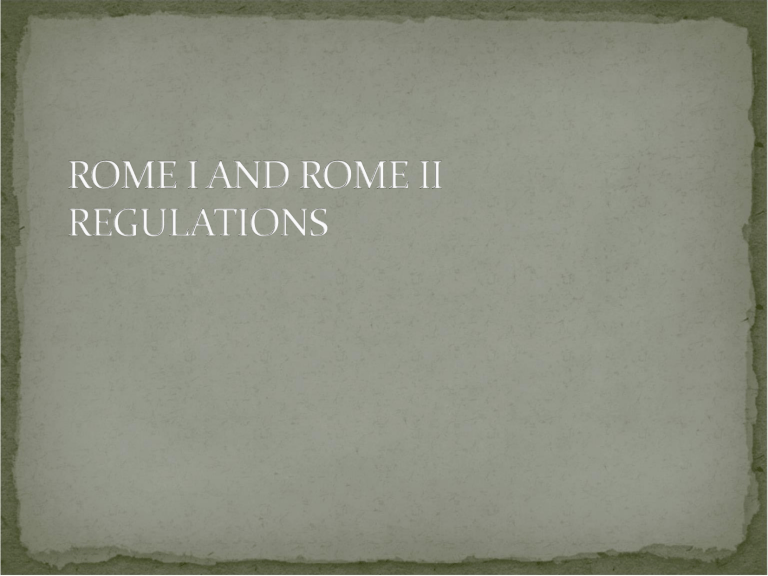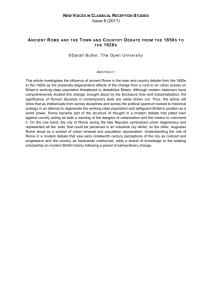Rome I Regulation - Dipartimento di Economia

The Rome Regulations can be seen as a single set of uniform rules which apply directly to European Member States and replace their domestic law.
The Regulations cover certain types of contractual, non-contractual, and pre-contractual obligations in those situations where there is a conflict of law.
The substantive scope of Rome I and Rome II Regulations should be consistent especially with the Brussels I Regulation, while together construing a solid legal basis for answering elementary questions which are arising in the area of internal common market and are of major importance for its proper functioning.
Private international law (sometimes referred to as the conflict of laws) deals with disputes between private persons, natural or legal, arising out of situations having a significant
connection or connections to more than one country.
The 1980 Rome Convention on the law applicable to contractual obligations (Rome I) lays down choice of law rules for
contractual claims. The rules are binding on all Member States.
So, for example, if an English court is hearing a contractual claim arising out of a contract between an English company and a
French company and the parties have, in that contract, chosen
French law to govern the contract, Rome I requires the English court to apply French law in order to decide the case.
The adoption of the Rome Regulations should be welcomed by all parties engaging in international transactions.
Rome I follows 11 months after the introduction in January 2009 of the Rome II Regulation and together they are the very new instruments of conflict-of-law rules in the area of Private
International Law in Europe.
Whilst the Rome I Regulation has reformed and replaced the
1980 Convention on the Law Applicable to Contractual
Obligations (the “Rome Convention”), uniform regulations detailing the governing law for non-contractual obligations
(such as the Rome II Regulation) is an absolute novelty for
European countries.
Both Regulations are dealing with the issues from civil and
commercial matters area. Nevertheless, we are only interested in “obligations” being them contractual or non contractual in their nature.
The rules are coordinated as a whole and aim to synchronise, on a continental scale, the laws applicable to legal relationships irrespective of the country of the court in which an action is
brought, and ultimately to further implement the European
internal market.
Both of the Rome Regulations recognise party autonomy and therefore allow parties to select their own governing law.
We must strictly refuse the view that there might be concurrent situations where both Rome I and Rome II will be possibly applicable.
According to our view, these two instruments are more allies then enemies because the basis of the obligation falling under the
Rome I or Rome II is very different in its nature: voluntary in the case of contractual obligations and non-voluntary in the case of non-contractual obligations.
The Rome I and II Regulations, both entering into force in 2009, bind the Member States of the European Union to a common set of rules for the choice of law in international private law disputes.
And their reach even extends to the application of non-Member
State law.
The Rome Convention on the law applicable to contractual obligations (“Rome I”) was agreed by Member States in 1980. It lays down uniform rules to determine the law applicable to contractual obligations in the Union. The "Rome I" Regulation replaces the Rome Convention of 1980, designed to harmonize conflicts of law between EU States.
Under Rome I, parties may agree on which law (which need not be the law of a Member State) is to be the law applicable to the contract and may change that choice of law at any time.
If the parties to a contract do not stipulate the law governing such contract, then Rome I Regulation sets out a number of rules.
Pursuant to the Rome I Regulation, as a general rule, where the parties do not choose the governing law, then contracts will be governed by the law of the country with which they are most closely connected.
The rules are intended to achieve the highest degree of predictability as to the applicable governing law, and, where necessary, to grant courts with the discretion required to determine the law that is most closely connected to the relevant situation.
The Regulation would lay down uniform rules to determine which national law should apply to issues in cases with an international dimension where the claim involves a non-contractual obligation
(such as a civil claim arising from a road traffic accident or a defamatory statement in a newspaper or a claim for the recovery of money paid by mistake).
The material scope of the Rome II proposal is set out in Article 1.
The Regulation applies to non-contractual obligations in “civil and commercial matters”.
The objective of Rome II is to ensure that courts in each of the
Member States apply the same choice of law rules to disputes involving non- contractual obligations, thereby increasing legal certainty and facilitating mutual recognition of judgments across the Union.
If the parties do not specify their choice of governing law, under the Rome II Regulation the general rule is that the law governing the non-contractual obligations between such parties is the lex loci damni, i.e. the law of the country in which the injury is sustained or the property is damaged.
The law applicable is to be the law of the country in which the damage arises or is likely to arise irrespective of the country in which the event giving rise to the damage occurred or of the country or countries in which indirect consequences of that event arise.
Non-contractual obligation rises not from the contract but from the breach of a duty defined by the objective law while the only relationship that is between the parties is factual one, definitely not a legal one.
To conclude our overall statements about both of these new instruments in the area of Private International Law, they are according to us definitely more allies than enemies.
Both regulations exist to provide legal certainty and predictability in the area of civil and commercial matters in the current situation in the European Union where the substantive unification of law is still missing.






